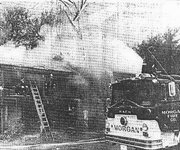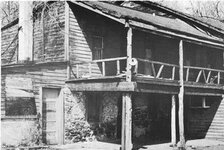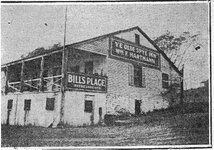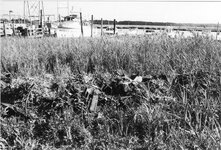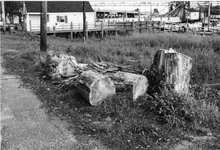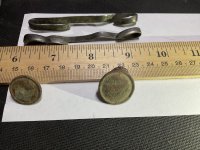Gypsy Heart
Gold Member
The mid-afternoon fire raged out of control as all four of the Township of Sayreville's fire companies fought to contain the blaze. It was just before Halloween, 24 years ago, and when the fire was finally contained, very little remained of the 273 year-old Old Spye Inn. Lost was not only an historic landmark, but also the home of numerous legends and reputed ghosts.
The Old Spye Inn was located at the foot of Old Spye Road in the Morgan section of Sayreville. Its history began in 1703 when the Morgan clan arrived from New York to settle the 645 acres that had been granted to them by New Jersey's first proprietors, John, Lord Berkeley and Sir George Carteret. The Morgans built their first homestead overlooking the mouth of the Crossways Creek near where it enters the Cheesequake Creek and just a few hundred yards inland from the Raritan Bay. As the family expanded the larger Morgan Manor was built up the hill overlooking the Raritan Bay, and their old home became a tavern and inn called the Morgan Inn. The Morgans were reportedly related to the famous pirate, Captain Henry Morgan, and he is said to have visited the Inn on more than one occasion.
The Morgans were a great supporter of the American cause during the Revolutionary War, and many family members served in the army with great esteem. It was during the war that Morgan Inn gained its most famous legend and its new name, the Old Spye Inn. A local loyalist by the name of Abe Mussey was captured by American troops signaling to British Ships on the Raritan Bay in 1777. He was tried as a spy at the inn and convicted at a one-day trial. Sentenced to death by hanging, his execution was carried out at a tree just 15 feet from the inn's entrance. Mussey's lifeless body was cut down the next day and buried behind the inn in an unmarked grave.
The Old Spye Inn continued business uneventfully until the time of the Civil War when a new legend was born. The Inn's proprietor was still a Morgan, James Rufus Morgan. It is alleged that a friendship developed him and the famous Confederate General Robert E. Lee. Their friendship was so strong that James named his first born son, Robert E. Lee Morgan. James was also a secret supporter of the Southern cause, manufacturing gunpowder and munitions on his estate and smuggling them to awaiting Confederate ships via a tunnel which led from the Old Spye Inn to the shore of the Raritan Bay. James' Southern sympathies eventually led to the break-up of the Morgan estate and the sale of the Inn, as he was never paid by the Confederacy for the supplies. It is interesting to note that munitions continued to be manufactured on what had been the Morgan estate until the spectacular explosion of the Gillespie Shell Loading Plant in 1918 within site of the Inn. There was also a restaurant named the Robert E. Lee Inn that burned down in the 1980's located at the exit point of the reputed tunnel.
By the 1880's two brothers named Applegate owned the Old Spye Inn, and they transformed it into a fishing and hunting club. Many wealthy and well-known individuals from both New York and New Jersey frequented the club, including Governor George Ludlow (1881-1884) who visited every summer to relax, and the famous newspaper man, Horace Greeley.
By the era of Prohibition, the Old Spye Inn was once again a tavern and occasional inn. The Cheesquake Creek was a favorite of "rum-runners" during this time. Small, low to the water speedboats would meet with ships offshore in international waters and take on cases of illegal liquor. They would then race to the shore to unload, often with the Coast Guard in hot pursuit. The Cheesequake Creek was a perfect "drop site" because its entrance was guarded by two low bridges that the bootleggers could fit under, but the larger Coast Guard ships could not. The bridge-keepers were also bribed to delay opening the bridges to ensure their escape. The smugglers would then drop the illegal cargo at one of the many hidden coves and docks (such as the Old Steamship Dock) along the creek.
Newbold Dickinson Pritchard was the owner of the Old Spye Inn during Prohibition and became one of its more colorful proprietors. "Dick," as he was known by everyone, was a baritone singer who had had his own radio program on WOR called "The Happy Bachelor." After changing his marital status, he decided to settle down, and purchased the Inn for him and his showgirl wife to manage. Because of its location, the Inn became a favorite haunt for the smugglers on the Cheesequake Creek, and they would often eat, drink and swap stories at it. Dick was a trusted comrade of the bootleggers, and would often watch out for them, warning them if he became aware of any information. Legs Diamond once left $191,000 in his care. Although Dick was happy with his new life, his wife Barry was not. She missed the limelight and never came to terms with being a cook, waitress and bartender. As she became more and more depressed, Dick would find her more and more on the wrong side of the bar, drinking and carousing with the customers instead of serving them. Eventually, the pressure of managing both the Inn and his wife got to Dick. Though he was never known as a drinking man, one morning in February, 1945, he locked himself in his room upstairs at the Inn and began drinking shouting curses at anyone who would try to talk to him through the closed door. Later that day the patrons at the Inn heard glass breaking and a scream. When they forced the door open, they found Dick in a pool of blood with both wrists slashed and a broken bear bottle nearby. A doctor was called, but it was too late. Dick was quickly cremated and his ashes were buried under the floorboards of the Inn.
The Old Spye Inn was always considered to be haunted by the people in the area. Perhaps it was its location, isolated at the foot of red brick road, seemingly a part of the swamp around it. Or perhaps it was its history, with spies, gangsters and suicides. Whatever the reason, many patrons often "felt" something when entering the bar. Others could see something swinging from a tree near the entrance. Often bottles would fall from shelves for no apparent reason, and voices and footsteps could be heard in the unused rooms above.
In the early 1960's the noted para-psychologist and author, Stanley Wojcik, moved to the Cheesequake section of Madison (now Old Bridge) near the Old Spye Inn. He was drawn to the venerable old building and could sense the spiritual activity around it. Wojcik began to hold seances using Ouija boards and spiritualists to contact the ghosts inhabiting the Inn. He was able to "speak" with all of the people mentioned in this short history, and dozens of others. Abe Mussey and Dick Pritchard were especially talkative. Wojcik would later write a novel, "Ye Old Spye Inn," a fictional story that incorporated the legends and spirits of the local landmark. As Wojcik said, "The ghosts around here just won't let me stop writing about the old place. Forces unseen have impelled me to do this story."
In 1975, about a year before the fire at the Old Spye Inn, Stanley Wojcik conceived and organized a re-creation of the arrest and trial of Abe Mussey. Local actors played the parts of Mussey and the American troops, while local politicians served as the judge and jury. The event was witnessed by hundreds of area residents, and at its conclusion an effigy of the spy was hung at a nearby tree. Sometime during the night the effigy disappeared, perhaps sensing the disaster that was to come, for the fire in 1976 proved the end of Old Spye Inn. The owner had no insurance, and after standing in ruins for years, it was eventually torn down. The site today remains vacant with only leftover debris at the rear of the site. The only physical testament to the Morgan family who originally settled the area and built the Inn, is a small cemetery overlooking the Raritan Bay. Spiritual traces, however, still remain as people continue to report unusual events at the end of Old Spye Road. If you visit the site of the Inn now, you can still sense the unease in the air. Perhaps it is the swaying swamp grass playing tricks with on your eyes, or the waves lapping at the shore playing tricks with your ears, but sometimes on a quiet fall evening at dusk, you can almost make out the body of Abe Mussey swinging in the breeze, and the baritone voice of Dick Pritchard greeting the ghostly patrons at the door of the now spectral Old Spye Inn.
SOURCES:
BOOKS:
Ye Old Spye Inn
By: Stanley L. Wojcik
Amboy Press, Inc., 1975
NEWSPAPERS:
The Matawan Journal
Matawan, New Jersey
The Newark Evening News
Newark, New Jersey
The News Tribune
Woodbridge, New Jersey
http://www.njhm.com/oldspyeinn.htm
The Old Spye Inn was located at the foot of Old Spye Road in the Morgan section of Sayreville. Its history began in 1703 when the Morgan clan arrived from New York to settle the 645 acres that had been granted to them by New Jersey's first proprietors, John, Lord Berkeley and Sir George Carteret. The Morgans built their first homestead overlooking the mouth of the Crossways Creek near where it enters the Cheesequake Creek and just a few hundred yards inland from the Raritan Bay. As the family expanded the larger Morgan Manor was built up the hill overlooking the Raritan Bay, and their old home became a tavern and inn called the Morgan Inn. The Morgans were reportedly related to the famous pirate, Captain Henry Morgan, and he is said to have visited the Inn on more than one occasion.
The Morgans were a great supporter of the American cause during the Revolutionary War, and many family members served in the army with great esteem. It was during the war that Morgan Inn gained its most famous legend and its new name, the Old Spye Inn. A local loyalist by the name of Abe Mussey was captured by American troops signaling to British Ships on the Raritan Bay in 1777. He was tried as a spy at the inn and convicted at a one-day trial. Sentenced to death by hanging, his execution was carried out at a tree just 15 feet from the inn's entrance. Mussey's lifeless body was cut down the next day and buried behind the inn in an unmarked grave.
The Old Spye Inn continued business uneventfully until the time of the Civil War when a new legend was born. The Inn's proprietor was still a Morgan, James Rufus Morgan. It is alleged that a friendship developed him and the famous Confederate General Robert E. Lee. Their friendship was so strong that James named his first born son, Robert E. Lee Morgan. James was also a secret supporter of the Southern cause, manufacturing gunpowder and munitions on his estate and smuggling them to awaiting Confederate ships via a tunnel which led from the Old Spye Inn to the shore of the Raritan Bay. James' Southern sympathies eventually led to the break-up of the Morgan estate and the sale of the Inn, as he was never paid by the Confederacy for the supplies. It is interesting to note that munitions continued to be manufactured on what had been the Morgan estate until the spectacular explosion of the Gillespie Shell Loading Plant in 1918 within site of the Inn. There was also a restaurant named the Robert E. Lee Inn that burned down in the 1980's located at the exit point of the reputed tunnel.
By the 1880's two brothers named Applegate owned the Old Spye Inn, and they transformed it into a fishing and hunting club. Many wealthy and well-known individuals from both New York and New Jersey frequented the club, including Governor George Ludlow (1881-1884) who visited every summer to relax, and the famous newspaper man, Horace Greeley.
By the era of Prohibition, the Old Spye Inn was once again a tavern and occasional inn. The Cheesquake Creek was a favorite of "rum-runners" during this time. Small, low to the water speedboats would meet with ships offshore in international waters and take on cases of illegal liquor. They would then race to the shore to unload, often with the Coast Guard in hot pursuit. The Cheesequake Creek was a perfect "drop site" because its entrance was guarded by two low bridges that the bootleggers could fit under, but the larger Coast Guard ships could not. The bridge-keepers were also bribed to delay opening the bridges to ensure their escape. The smugglers would then drop the illegal cargo at one of the many hidden coves and docks (such as the Old Steamship Dock) along the creek.
Newbold Dickinson Pritchard was the owner of the Old Spye Inn during Prohibition and became one of its more colorful proprietors. "Dick," as he was known by everyone, was a baritone singer who had had his own radio program on WOR called "The Happy Bachelor." After changing his marital status, he decided to settle down, and purchased the Inn for him and his showgirl wife to manage. Because of its location, the Inn became a favorite haunt for the smugglers on the Cheesequake Creek, and they would often eat, drink and swap stories at it. Dick was a trusted comrade of the bootleggers, and would often watch out for them, warning them if he became aware of any information. Legs Diamond once left $191,000 in his care. Although Dick was happy with his new life, his wife Barry was not. She missed the limelight and never came to terms with being a cook, waitress and bartender. As she became more and more depressed, Dick would find her more and more on the wrong side of the bar, drinking and carousing with the customers instead of serving them. Eventually, the pressure of managing both the Inn and his wife got to Dick. Though he was never known as a drinking man, one morning in February, 1945, he locked himself in his room upstairs at the Inn and began drinking shouting curses at anyone who would try to talk to him through the closed door. Later that day the patrons at the Inn heard glass breaking and a scream. When they forced the door open, they found Dick in a pool of blood with both wrists slashed and a broken bear bottle nearby. A doctor was called, but it was too late. Dick was quickly cremated and his ashes were buried under the floorboards of the Inn.
The Old Spye Inn was always considered to be haunted by the people in the area. Perhaps it was its location, isolated at the foot of red brick road, seemingly a part of the swamp around it. Or perhaps it was its history, with spies, gangsters and suicides. Whatever the reason, many patrons often "felt" something when entering the bar. Others could see something swinging from a tree near the entrance. Often bottles would fall from shelves for no apparent reason, and voices and footsteps could be heard in the unused rooms above.
In the early 1960's the noted para-psychologist and author, Stanley Wojcik, moved to the Cheesequake section of Madison (now Old Bridge) near the Old Spye Inn. He was drawn to the venerable old building and could sense the spiritual activity around it. Wojcik began to hold seances using Ouija boards and spiritualists to contact the ghosts inhabiting the Inn. He was able to "speak" with all of the people mentioned in this short history, and dozens of others. Abe Mussey and Dick Pritchard were especially talkative. Wojcik would later write a novel, "Ye Old Spye Inn," a fictional story that incorporated the legends and spirits of the local landmark. As Wojcik said, "The ghosts around here just won't let me stop writing about the old place. Forces unseen have impelled me to do this story."
In 1975, about a year before the fire at the Old Spye Inn, Stanley Wojcik conceived and organized a re-creation of the arrest and trial of Abe Mussey. Local actors played the parts of Mussey and the American troops, while local politicians served as the judge and jury. The event was witnessed by hundreds of area residents, and at its conclusion an effigy of the spy was hung at a nearby tree. Sometime during the night the effigy disappeared, perhaps sensing the disaster that was to come, for the fire in 1976 proved the end of Old Spye Inn. The owner had no insurance, and after standing in ruins for years, it was eventually torn down. The site today remains vacant with only leftover debris at the rear of the site. The only physical testament to the Morgan family who originally settled the area and built the Inn, is a small cemetery overlooking the Raritan Bay. Spiritual traces, however, still remain as people continue to report unusual events at the end of Old Spye Road. If you visit the site of the Inn now, you can still sense the unease in the air. Perhaps it is the swaying swamp grass playing tricks with on your eyes, or the waves lapping at the shore playing tricks with your ears, but sometimes on a quiet fall evening at dusk, you can almost make out the body of Abe Mussey swinging in the breeze, and the baritone voice of Dick Pritchard greeting the ghostly patrons at the door of the now spectral Old Spye Inn.
SOURCES:
BOOKS:
Ye Old Spye Inn
By: Stanley L. Wojcik
Amboy Press, Inc., 1975
NEWSPAPERS:
The Matawan Journal
Matawan, New Jersey
The Newark Evening News
Newark, New Jersey
The News Tribune
Woodbridge, New Jersey
http://www.njhm.com/oldspyeinn.htm


